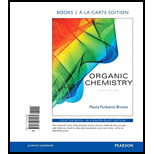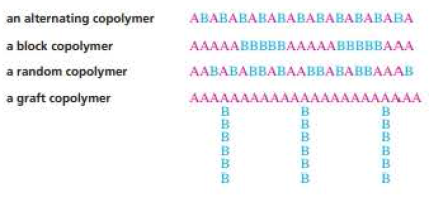
Organic Chemistry, Books a la Carte Edition (8th Edition)
8th Edition
ISBN: 9780134074580
Author: Bruice, Paula Yurkanis
Publisher: PEARSON
expand_more
expand_more
format_list_bulleted
Concept explainers
Question
Chapter 27, Problem 39P
Interpretation Introduction
Interpretation:
The mechanism for the formation of the given alternating copolymer has to be proposed.
Concept Introduction:
Monomers combine together to form polymers. Monomers are the repeating units of small molecules which link together to form polymers and the process is called as
Two types of polymers:
- Synthetic and biopolymers.
- DNA is an example for biopolymer and these type of polymers are synthesized by cells.
- Polymers synthesized by scientists are called
synthetic polymers and some examples are nylon, polyester etc.
Two types of synthetic polymers:
- Chain-growth
polymers or addition polymers and step-growthpolymers or Condensation polymers. - Chain growth polymers are formed by the monomer addition to the end of a growing chain.
- Step-growth polymers are formed by combining monomers by removing small molecules of water or alcohol.
- Polymers formed from two or more different monomers are called copolymers.
- Classified into alternating copolymer, block copolymer, graft copolymer and also random copolymer.

Expert Solution & Answer
Want to see the full answer?
Check out a sample textbook solution
Students have asked these similar questions
Provide the mechanism for the step-growth polymerization of citric acid and ethylene glycol to form poly (ethylene glycol)-citrate. Show all steps.
The following two compounds form a 1 : 1 alternating copolymer. No initiator is needed for the polymerization. Propose a mechanism for formation of the copolymer.
Macromolecules can also be formed from cyclic monomers such as cyclic hydrocarbons, ethers, esters, amides, siloxanes, and sulfur (eight-membered ring). Thus, ring-opening polymerization is of particular interest, since macromolecules of almost any chemical structure can be prepared. Choose two of the above type polymers to explain the mechanism and chemical reaction of polymerization process.
Chapter 27 Solutions
Organic Chemistry, Books a la Carte Edition (8th Edition)
Ch. 27.3 - Prob. 1PCh. 27.3 - Prob. 2PCh. 27.3 - Prob. 3PCh. 27.3 - Prob. 4PCh. 27.3 - Prob. 5PCh. 27.3 - Prob. 6PCh. 27.4 - Prob. 7PCh. 27.5 - Rank the following groups of monomers from most...Ch. 27.5 - Why does methyl methacrylate not undergo cationic...Ch. 27.6 - Prob. 10P
Ch. 27.6 - Explain why, when propylene oxide undergoes...Ch. 27.6 - Which monomer and which type of initiator can you...Ch. 27.6 - Prob. 13PCh. 27.8 - Draw a short segment of gutta-percha.Ch. 27.8 - Prob. 15PCh. 27.11 - Prob. 16PCh. 27.11 - Write an equation that explains what happens if a...Ch. 27.11 - What happens to polyester slacks if aqueous NaOH...Ch. 27.11 - a. Propose a mechanism for the formation of the...Ch. 27.11 - Explain why, when a small amount of glycerol is...Ch. 27.12 - Propose a mechanism for the formation of melmac.Ch. 27.12 - Prob. 22PCh. 27.13 - Prob. 23PCh. 27 - Draw short segments of the polymers obtained from...Ch. 27 - Prob. 25PCh. 27 - Prob. 26PCh. 27 - Draw the structure of the monomer or monomers used...Ch. 27 - Prob. 28PCh. 27 - Draw short segments of the polymers obtained from...Ch. 27 - Quiana is a synthetic fabric that feels very much...Ch. 27 - Prob. 31PCh. 27 - Prob. 32PCh. 27 - Prob. 33PCh. 27 - Poly(vinyl alcohol) is a polymer used to make...Ch. 27 - Five different repeating units are found in the...Ch. 27 - Prob. 37PCh. 27 - A particularly strong and rigid polyester used for...Ch. 27 - Prob. 39PCh. 27 - Which Monomer gives a greater yield of polymer,...Ch. 27 - Prob. 41PCh. 27 - Prob. 42PCh. 27 - Why do vinyl raincoats become brittle as they get...Ch. 27 - The polymer shown below is synthesized by...Ch. 27 - Prob. 45PCh. 27 - How can head-to-head poly(vinyl bromide) be...Ch. 27 - Delrin (polyoxymethylene) is a tough...
Knowledge Booster
Learn more about
Need a deep-dive on the concept behind this application? Look no further. Learn more about this topic, chemistry and related others by exploring similar questions and additional content below.Similar questions
- Draw the structure of the polymer formed from ring-opening metathesis polymerization (ROMP) of each monomer.arrow_forwardDraw the structure of the polymer formed by step-growth polymerization of each monomer or pair of monomers.arrow_forwardDraw the structure of the polymer formed by chain-growthpolymerization of each monomerarrow_forward
- Draw the structure of the polymer that results from anionic polymerization of p-trichloromethylstyrene (CCl3C6H4CH =CH2) using ethylene oxide as the electrophile to terminate the chain.arrow_forwardPolymethyl acrylate (PMMA) can be prepared by anionic addition polymerization. Propose a mechanism using t-butyl lithium as an initiator.arrow_forwardThe structure of propylene is shown. This alkene undergoes addition polymerization to form polypropylene, a thermoplastic polymer with many different applications.arrow_forward
- Teflon can be made from tetrafluoroethylene by means of a free radical polymerization. In the reaction, termination occurs only by combination and not by disproportionation. Explain this observation.arrow_forwardNylon 6,10 is prepared by polymerization of a diamine and a diacid chloride. Draw a structural formula for each reactant and for the repeat unit in this polymer.arrow_forwardUse resonance structures to explain the stabilization of the intermediate formed in the cationic polymerization of styrene to form polystyrene.arrow_forward
- Given the structures of the monomers, predict whether the polymer will be achain-growth polymer or a step-growth polymer, and draw the structure of the polymer chain.arrow_forwardDraw a polymer chain segment of a copolymer formed when the two monomers given below are polymerized using a radical initiator. H₂C: H₂N CH3 H₂C: H₂Carrow_forwardThe following diagram shows a polymer with four repeating units. Identify the correct monomer that was needed to form this polymer. H3 H₂ нснснсн | | | | с-с-с-с-с-с-с-с+ | | | | | | нннннн Н T a) С н-с-с Oc) H₂C Н- T H Н Н Н Н Н C- Г -C H CH3 Н O d) Н Н Н Ж H Н Н Н Н н н CH3 На C-H H HU I Н Н Н С -с-с-H A н нarrow_forward
arrow_back_ios
SEE MORE QUESTIONS
arrow_forward_ios
Recommended textbooks for you
 Chemistry: Principles and PracticeChemistryISBN:9780534420123Author:Daniel L. Reger, Scott R. Goode, David W. Ball, Edward MercerPublisher:Cengage Learning
Chemistry: Principles and PracticeChemistryISBN:9780534420123Author:Daniel L. Reger, Scott R. Goode, David W. Ball, Edward MercerPublisher:Cengage Learning

Chemistry: Principles and Practice
Chemistry
ISBN:9780534420123
Author:Daniel L. Reger, Scott R. Goode, David W. Ball, Edward Mercer
Publisher:Cengage Learning